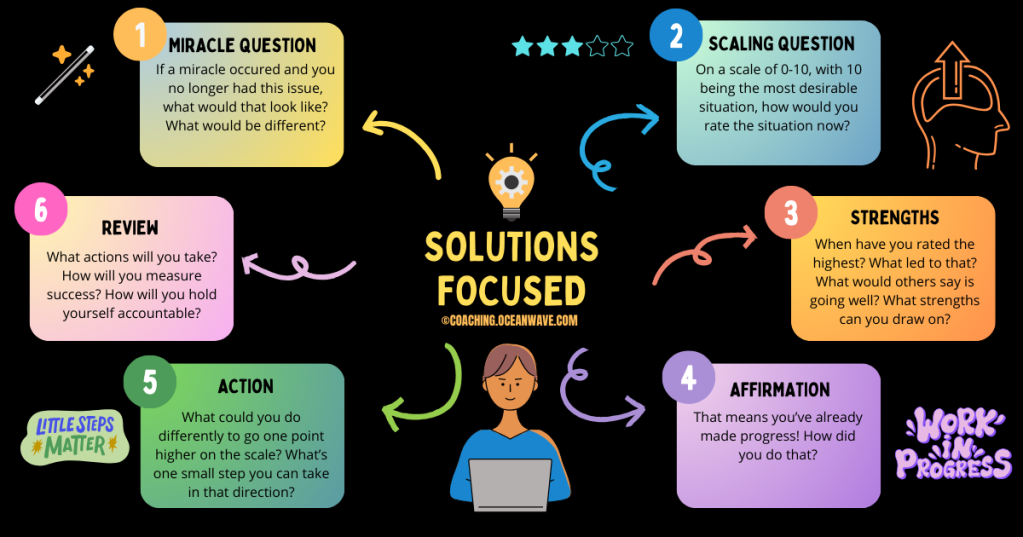
You know when you’re surrounded by problems, and instead of finding solutions, it seems like you’re mired in quicksand? The more you grasp at answers, the more elusive they become. You wind up spinning your wheels and feeling frustrated and overwhelmed. But what if you focused on imagining a better future instead of being sucked in by the problems? Shifting your focus to what could go right can open up new possibilities, get things moving again, and create a more positive, proactive vibe that sparks teamwork and fresh ideas.
A great example of this was an engineering leader who was in the thick of it after their company had gone through another round of layoffs. Like many of you, they were being pressured to do more with less. Budgets were tight, resources stretched thin, and their teams were understandably disengaged and unmotivated. The pressure was building, and it was tough to see a way out.
I asked them the solutions-focused miracle question to help them get unstuck: “What would it look like if a miracle happened overnight and tomorrow things were running smoothly?” Without missing a beat, they instantly started rattling off a list, painting a pretty clear and detailed picture:
- Projects were delivered on time and within scope.
- Communication flowed seamlessly across all levels, from engineers to the exec team, ensuring everyone was aligned and in the loop.
- Because they had the necessary context, their teams were motivated and solving problems with a high degree of autonomy.
- Meetings were focused and efficient and helped the teams progress instead of rehashing the same issues.
- Everyone embodied a culture of collaboration and trust, working together towards common goals, sharing knowledge and resources.
- Work had clear priorities that aligned with the company’s strategic direction and was balanced across the teams
- Constructive feedback loops were fostering continuous improvement.
- Resources were allocated effectively and there was enough slack to address emerging risks and opportunities.
When you look at this list, you’re probably thinking “Sure, that’s what we all want, but come on, be realistic!” But just saying those things and writing them down was a turning point that helped them feel more in control of the situation.
Next, I asked them to rate their current situation on a scale from 0 to 10, where 10 represented that best possible future. Their gut feeling placed their organization at a 4. When I asked what was going well, they mentioned the overall quality of their organization’s work, despite tight deadlines, and a team that delivered a critical feature ahead of schedule. There was also a strong sense of camaraderie in some departments, making them more resilient in the face of change and stress.
In the end, they had a solid list of sixteen things that were going well. We took a moment to recognize and celebrate the foundation they already had, which really boosted their mood. When I asked what strengths they and the team had, and what things they did in the past when things were better, they started nodding and scribbling down notes (with an actual pen!) about things that had more recently fallen by the wayside. A few of those included:
- Their weekly roundup message that helped provide context across the entire department.
- Integrating product, design, security and engineering in a vertical slice for each project.
- Frequent shoutouts in their celebratory slack channel.
- Having dedicated Product Owners act as the voice of the customer so developers felt more engaged with the outcomes of their work.
Some things they mentioned were no longer doable, but asking if there were alternatives that might fulfill the same purpose had them jotting down more notes. I could see the change happening right in front of me. Their slumped shoulders straightened, their head lifted, and their voice grew more energetic and confident.
By the time I asked, “What would it take to bump up your rating by just one point?” they had a bunch of ideas ready to go. As we wrapped up our conversation, I asked what next step they wanted to commit to, how they’d measure success, and how they’d keep themselves accountable. Here’s the initial plan they settled on:
- Have managers model team and individual celebration by making space in their weekly team meetings to share appreciation of each other. Also have them re-kickstart the shoutouts in the department slack channel to get the positive vibes going again.
- Instead of each department head publishing their own roll up, create a shared message that summarized the cross-departmental checkin meeting. This would share context in a more time efficient manner.
- Create per-project communication channels within each product line instead of having the majority of the information siloed in one department. Even if they couldn’t dedicate one person from every department to a team anymore, they could at least share key pieces of information asynchronously.
To track how things were going, they decided to have each manager run a baseline retro to ask questions about knowledge, empowerment, and engagement. Then they’d touch base with another retro each month for a quarter to see if things improved. They expected at least two outcomes to be more positive chatter about projects and fewer surprises in the cross-departmental meetings as everyone got better aligned.
They also decided to share their plan with other leaders and ask for their help to keep each other accountable for making improvements. We agreed to check in on their progress in two weeks to see how things were going, too.
Spoiler alert! They kept working on incremental steps and turned things around over the next quarter. moving up to a 7 on the ratings scale!
In the end, shifting focus from the problems to the possibilities was the spark they needed. Their anxiety and sense of helplessness decreased, and they reignited a sense of purpose and motivation within their team. By envisioning a brighter future, recognizing existing strengths, and taking small, practical steps to improve, they laid the groundwork for sustainable progress.
The next time you’re feeling stuck, try taking a solutions-focused approach, starting with some variation on the magic question “How would it look if we had already overcome this challenge?”

Leave a comment